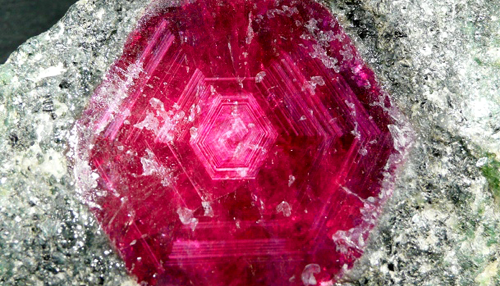Ruby
Ruby is corundum occurring in various shades of red. It possesses a hardness of 9 on the Mohs scale, and has a refractive index of 1.762-1.77 and a 3.97 - 4.05 specific gravity.
Ruby is the birthstone for the month of July and the gemstone representing the fifteenth and fortieth wedding anniversaries.
It is known as the stone of love and is capable of reconciling lovers' quarrels. Ruby is given as a symbol of success, devotion, integrity, health, and passion. The gem was once thought to ward off misfortune and ill-health and to endow health, happiness and wisdom onto its wearer. It was also considered a remedy for various ailments, and was an important component of the medicine chest in the Middle Ages.

Ruby ring
Peoples of the East would insert a ruby into a cut in the skin above an artery, believing that the gemstone would infuse great courage and wisdom into their blood. On account of its rarity, rulers used it as a symbol of their wealth and power. Ruby is mentioned in the Bible as one of the gemstones on the High Priest's breastplate.
Rubies are mainly found in southern Asia and central to southern Africa.
Myanmar is considered to be the world's most precious source for rubies. The two main sources are Mogok and Mong-Hsu. The preferred color of the Myanmar ruby is termed Pigeon's Blood, a deep red with a slightly purplish hue. It can be compared to the color of glowing coal, or to that of a red traffic light.
Thailand main sources of rubies are Kanchanaburi and Chantaburi. Thai rubies commonly possess a darker tone than the Myanmar gems, commonly exhibiting a brownish or purplish tint, which sometimes dominates almost the entire color of the gem.
Ruby is found in many areas of Sri Lanka. Most of the Sri-Lankan rubies possess a deeply saturated strongly pinkish Red hue with a tone that tends to be light, weaker than the colors of the Myanmar variety.
Vietnam main sources of ruby are Luc Yen and Quy Chau. From time to time, rubies displaying the somewhat pinkish-red appearance of Myanmar rubies have been discovered in these deposits.
Other ruby deposits in Asia are located in Tajikistan, Afghanistan, Northern Pakistan in the Hunza Valley, Laos, Nepal, Cambodia and India, where deposits with relatively large crystals were discovered in the federal states of Mysore and Orissa.

Ruby crystal
Mozambique is the most important African source, and a rising star among the recently discovered ruby sources around the world. The Montepuez mine was opened in 2009 and has become the dominant alternative source for pigeon blood colors. In the past, Mozambique was known only for low-grade rubies and the Lichinga area was its most important source.
Another important African source is Madagascar, where two of its main deposits are Vatomandry and Andilamena in Eastern Madagascar.
Tanzania posses at least a dozen locations scattered all over the country. The most significant ones being the Longido mine in northern Tanzania producing large opaque, dark brownish red rubies, surrounded by green zoisite; the Umba River, the Morogoro area and Winza, known for its fine pinkish red, Burmese-type hue, albeit its small yield.
Other African sources include Kenya, Malawi and Nigeria.
Additional sources around the world include Australia and USA, in North Carolina and Montana.
| Gemological Properties: | |
| Species: | Corundum |
| Chemical composition: | Be3Al2O3 |
| Crystal system: | Trigonal |
| Hardness: | 9 |
| Color: | Red |
| Optic sign: | DR Uniaxial |
| Refractive Index: | 1.762 to 1.770 |
| Specific Gravity: | 3.97-4.05 |
| Enhancements: | H-Heating, F-Filling, O-Oiling/Resin Infusion, D-Dyeing, U-Diffusion |

